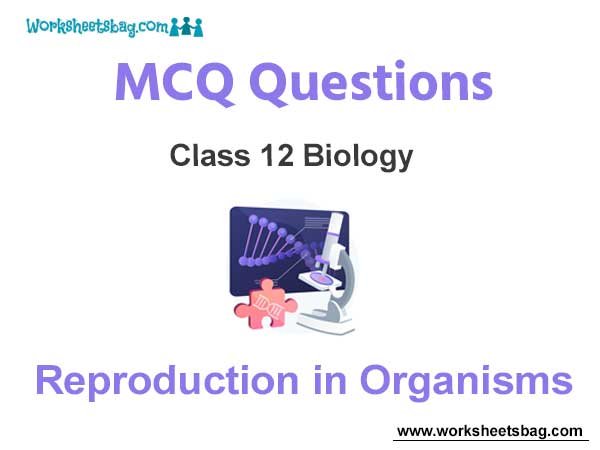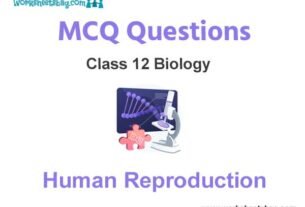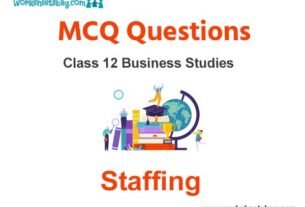Please refer to Reproduction in Organisms MCQ Questions Class 12 Biology below. These MCQ questions for Class 12 Biology with answers have been designed as per the latest NCERT, CBSE books, and syllabus issued for the current academic year. These objective questions for Reproduction in Organisms will help you to prepare for the exams and get more marks.
Reproduction in Organisms MCQ Questions Class 12 Biology
Please see solved MCQ Questions for Reproduction in Organisms in Class 12 Biology. All questions and answers have been prepared by expert faculty of standard 12 based on the latest examination guidelines.
MCQ Questions Class 12 Biology Reproduction in Organisms
Question-“How organisms reproduce” – depends upon –
(a) Habitat of organisms.
(b) Internal physiology of organisms
(c) Genetic make up
(d) All of the above factors
Answer
D
Question- Which of the following parts are used for reg. repdn in pistia-
(a) Runners
(b) Offsets
(c) Suckers
(d) Stolar
Answer
B
Question- In which of the following fertilized eggs are covered by hard calcareous shell?
(a) Frog
(b) Reptiles and birds
(c) Mammals
(d) Frog and Toad
Answer
B
Question-Asexual reproduction is common –
(a) Among single celled organisms only
(b) Among plants only
(c) Among single celled organisms, plants and all animals
(d) Among single celled animals, plants and animals with simple organizations
Answer
D
Question- Seeds are called products of semual reproduced because they-
(a) Give rise to new plants
(b) Are formed by fsion of gametes
(c) Can be stored for a long time
(d) Are formed by fusion of pollar tubes
Answer
B
Question- In animals and other simple organisms uniparental reproduction is called, called _______ reproduction
(a) vegetative, asexual
(b) Asexual, vegetative
(c) Parthenogenetic, Amphimictic
(d) A” phimictic, Apomictic
Answer
B
Question-Vegetative propagation in mint occurs by-
(a) offset
(b) Rhizome
(c) Sucker
(d) Runner
Answer
C
Question- Ploidy of ovary, anther, egg, pollen, male gamete and zygote are respectively –
(a) 2n, 2n, n, 2n, n,2n
(b) 2n, 2n, n, n, n, 2n
(c) 2n, n, n, n, n, n
(d) 2n, 2nr n, 2n, 2n, 2n
Answer
B
Question- A. The plant was introduced in India because of its beautiful flowers and shape of leaves
B. It can propagate vegetatively at a phenomenal rate and spread all over water body in a short period
C. It is very difficult to get rid off these plants A to C points are related to –
(a) Dahlia
(b) Water hyacinth
(c) Azolla (water fern)
(d) Mosses
Answer
B
Question- In grafting contact in made between-
(a) Cambium
(b) Flower
(c) Xylen
(d) Phloem
Answer
A
Question- The fastest method to obtain clones is through –
(a) induced mutation
(b) parasexual hybridization
(c) parthenogenesis
(d) vegetative reproduction-
Answer
D
Question-No individual is immortal except-
(a) Single celled organisms
(b) Green plants
(c) Sponges
(d) Drones
Answer
A
Question-Some organisms are capable of asexual or sexual reproduction. Under favourable conditions, reproduction proceeds asexually.
When conditions become more stressful reproduction switches to a sexual mode. Why?
(a) Sexual reproduction is simple and more rapid allowing larger numbers of offspring to be produced
(b) Sexual reproduction requires two separate individuals, who can mutually provide nutrient support during stress
(c) Sexual reproduction produces individuals with new combinations of recombined chromosomes increasing diversity
(d) Asexual reproduction requires more energy
Answer
C
Question- In Monerans (e.g. bacteria) and Protists (Amoeba, Paramecium, Euglena, etc) asexual reproduction occurs by-
(a) Budding
(b) Multi fission
(c) Binary fission
(d) Amphimixis
Answer
C
Question- Bamboo species Hovers-
(a) Every year
(b) Once is 12 years
(c) Only once in life time
(d) Twice is in 50-100 year
Answer
C
Question- Clone is the product of-
(a) Sexual reproduction
(b) Sexual or asexual reproduction
(c) Amphimixis
(d) Asexual reproduction
Answer
D
Question- Individuals of a clone-
(a) Are genetically similar but morphologically different
(b) Are morphologically similar but genetically different
(c) Are morphologically and genetically similar
(d) Are genetically and phenotypically different
Answer
C
Question- A scion in grafted on stock. The quality of fruits produced will be determined by the gero type of-
(a) Stock
(b) Scion
(c) Both Stock and Scion
(d) Neither stock or scion
Answer
B
Question- In small flies such as Miastor, reproduction occurs in larval stage, it is called-
(a) neoteny
(b) paedogenesis
(c) patherogenesis
(d) patherocoupy
Answer
B
Question- The period from birth to the natural death of an organism represents-
(a) Reproductive phase
(b) Life cycle
(c) Life span
(d) Life style
Answer
C
Question- Bamboo species Hovers-
(a) Every year
(b) Once is 12 years
(c) Only once in life time
(d) Twice is in 50-100 year
Answer
C
Question- Which of the following statements is false?
(a) Asexual reproduction is simpler than sexual reproduction
(b) Asexual reproduction occurs by fission, budding and fragmentation
(c) In most of the animals both asexual and sexual modes of reproduction are found
(d) Vegetative and sexual modes of reproduction are exhibited by the higher plants
Answer
C
Question- Which of the following statements is true about water hyacinth?
(a) It gives useful products to be used in medicine
(b) It is a marine plant
(c) It takes oxygen from water which causes death of fishes
(d) It is being cultivated in sea water for biogas
Answer
C
Question- Which of the following animal is laving longitudinal binary fission.
(a) Euglena
(b) Plasmodium
(c) Planaria
(d) Paramoecium
Answer
A
Question- Select the correct sequence from the following.
I. Juvenile phase —> Senescent phase —> Reproductive phase
II. Juvenile phase —> Reproductive phase —> Senescent phase
III. Reproductive phase —> Juvenile phase —> Senescent phase
IV Vegetative phase —> Reproductive phase —> Senescent phase
(a) I and II
(b) I and IV
(c) III and IV
(d) II and.IV
Answer
D
Question- Select the correct sequence from the following –
(a) Gametogenesis —>Syngamy -—> Zygote —> Embryogenesis
(b) Gametogenesis —> Syngamy —> Embryogenesis —> Zygote
(c) Zygote —> Embryogenesis —> Gametogenesis
(d) Syngamy —> Gametogenesis —> Zygote —> Embryogenesis
Answer
D
Question- Spermatids are transformed into spermatozoa by-
(a) Spermitation
(b) Supermatogenesis
(c) Supermiogenesis
(d) Supermatosis
Answer
C
Question- Which of the following plants do not show clear cut vegetative, reproductive and senescent phase?
(a) Perennial plants
(b) Annual plants
(c) Biennial plants
(d) Either b or c
Answer
A
Question- Which of the following sequences of organisms is correct in respect of life spans?
(a) Banyan tree > Parrot > Elephant > Crocodile > Crow
(b) Crow > Crocodile > Elephant > Parrot > Banyan tree
(c) Banyan tree > Elephant > Crocodile > Parrot > Crow
(d) Crow > Parrot > Elephant > Crocodile > Banyan tree
Answer
A
Question- Which of the following is correct about Strobilanthus kunthiana?
(a) It flowers once in 12 years.
(b) The plant came to flower last time in September-October 2006.
(c) Its mass flowering converted large hilly tracts of Kerala, Karnataka and Tamil Nadu into blue stretches that attracted a large number of tourists
(d) AII
Answer
D
Question- Which of the following regulates the reproductive processes and the associated behavioural expressions of organisms?
(a) Hormones
(b) Environmental factors
(c) Abiotic components
(d) Interaction between hormones and environmental factors
Answer
D
Question- In flowering plants both male and female gametes are non-motile. The method to bring them together foffertilization is –
(a) Water only
(b) Air only
(c) Pollination
(d) Apomixis
Answer
C
Question-Find out the organism with highest life span –
(a) Tortoise
(b) Horse
(d) Fruit fly
(c) Dog
Answer
A
Question- Meiosis-
(a) does not take place in organisms showing asexual reproduction only
(b) takes place in sexually reproducing haploid organism
(c) takes place in sexually reproducing diploid organism
(d) all of the above are correct
Answer
D
Question- In which of the following organism, self fertilisation in seen.
(a) Fish
(b) Roundworm
(c) Earth worm
(d) River flike
Answer
D
Question- In majority of organisms male gamete is _______ and female gamete is ________.
(a) Motile, motile
(b) Non-motile, non-motile
(c) Non-motile, motile
(d) Motile, stationary (non-motile)
Answer
D
Question- Find out the correct statement –
(a) Life spans of organisms are necessarily correlated with their sizes
(b) The sizes crows and parrots are not very different, so their life spans are almost similar
(c) A peepal tree has much shorter life span as compared to a mango tree
(d) Reproduction is essential for continuity cf species on the earth
Answer
D
Question- Transverse binary fission occurs in-
(a) Euglena
(b) Amoeba
(c) Hydra
(d) Paramecium
Answer
D
Question- Which of the following is a false statement?
(a) All organisms have evolved similar mechanism to multiply and produce offsprings
(b) Asexual reproduction is uniparental
(c) Sexual reproduction is biparental
(d) In asexual reproduction no fertilization occurs
Answer
A
Question- Oestrus cycle is seen in –
(a) Cows and sheep
(b) Rats and deers
(c) Dogs and tiger
(d) AII
Answer
D
Question- Among the following which one is not a method of asexual reproduction
(a) Budding (e.g. yeast)
(b) Layering
(c) Sowing
(d) Binary fission
Answer
C
Question- Animals which give birth to young ones are said to be –
(a) Viviparous
(b) Amphibious
(c) Coelomates
(d) Oviparous
Answer
A
Question- Which of the following is not vegetative propagule?
(a) Rhizome and sucker
(b) Tuber and offset
(c) bulbil (e.g. in Agave), leaf buds, bulb
(d) Antherozoid
Answer
D
Question- Which of the following is viviparous?
(a) Reptiles
(b) Frog
(c) All mammals
(d) Majority of mammals
Answer
D
Question- Find the covert combination-
(a) Zoospore in sponge
(b) Conidia in Algae
(c) Genmules in Pericillium
(d) Buds in hydra
Answer
D
Question- Which of the following is cultivated through vegetative propagation –
(a) Potato and Sugarcane
(b) Banana and Ginger
(c) Dahlia and Rose
(d) All
Answer
D
Question- Ciliated motile spores are called-
(a) Aplanospores
(b) Conidia
(c) Zoospores
(d) Oospones
Answer
C
Question- Menstrual cycle is reported in –
(a) Only humans
(b) Only apes
(c) Only monkey
(d) Primates like humans, apes and monkey
Answer
D
Question- Birds in captivity (as in poultry farms) can be made to lay eggs throughout the year. In this case laying eggs is –
(a) Related to reproduction and a commercial exploitation for human welfare.
(b) Neither related to reproduction nor a commercial exploitation for human welfare.
(c) Not related to reproduction but a commercial exploitation for human welfare.
(d) Related to reproduction but not a commercial exploitation for human welfare.
Answer
C
Question- Which of the following are seasonal breeders?
(a) frogs
(b) Birds
(c) Lizards
(d) AII
Answer
D
Question- Offsprings of oviparous animals are at greater risk as compared to offsprings of viviparous animals because –
(a) Proper embryonic care and protection is lesser
(b) Embryo is not developed
(c) Progenies are with more variation
(d) Progenies are larger
Answer
A
Question- The motile reproductive structure of algae and fungi, which directly give rise to new individuals one called-
(a) Cysts
(b) Conidia
(c) Buds
(d) Zoospores
Answer
D



